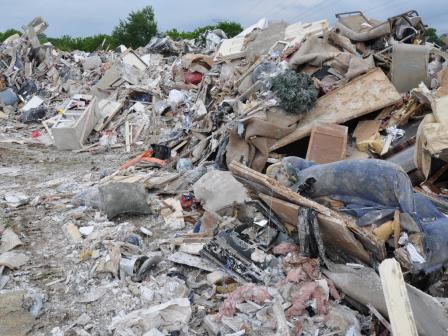Northeast Indiana Counties Collaborate to Develop Debris Management Plans

Climate change is expected to increase the frequency and severity of storms in many communities. Such storms are likely to increase the needs of communities to safely and effectively manage disaster debris. In addition to preparing for the immediate response after a disaster, disaster debris management planning may also help communities adapt to anticipated changing climate by ensuring future transportation routes and debris staging areas are established in less vulnerable areas. Anticipating this increased need, several Northeast Indiana counties—Noble, LaGrange, Steuben, and DeKalb—developed debris management plans with the Northeast Indiana Solid Waste Management District (NISWMD). The planning process included: a series of scoping meetings among key stakeholders (county emergency management agencies, NISWMD, county highway officials, and other elected officials); identifying existing local, state and federal resources for developing a plan; benchmarking debris management plans from other counties; and reviewing relevant federal and state guidelines.
The resulting county-level plans addressed: management and storage options, including recycling and composting; Geographic Information System (GIS) maps identifying vulnerable transportation routes; potential removal and transportation contractors, including those outside of the counties to ensure anticipated capacity needs; and a tracking system to ensure debris was managed as desired. To ensure timely deployment, the plans included training and key materials such as checklists, job descriptions, and site “Deployment packages” consisting of maps, phone numbers, and specific instructions. The debris management plans are living documents; these are constantly updated as the parties learn more information and find new opportunities to improve.
|
How did they do it? |
Applicable EPA Tools |
|---|---|
|
Step #1: Held a series of stakeholder meetings County emergency management agencies, highway departments, and elected officials met with the Northeast Indiana Solid Waste Management District to develop a method for developing each county’s Disaster Debris Management plan. |
To help communities prepare, EPA provides disaster debris planning resources. |
|
Step #2: Assessed the local adaptive capacity Participating counties estimated how much debris there could be under different scenarios for planning purposes. Team members used GIS to determine locations that could receive and process disaster debris; routes that could become inundated with debris during a disaster; and the best routes to transport debris to the processing sites. |
EPA’s Planning for Natural Disaster Debris guides communities to create disaster debris management plans. The Regional Resilience Toolkit helps regions plan for disasters, such as those caused by more frequent and intense storms, by working across multiple jurisdictions and with nongovernmental partners. |
|
Step #3: Developed Disaster Management Plans County officials determined who would be responsible for each aspect of their plans and created contact lists that are updated regularly. Participating counties are regularly meeting to assess the plans and determine if anything needs to change and updating the plan accordingly. Parties are continuing to update training protocols for both pre-event trainings and trainings that would occur during an event. |
FEMA’s Debris Management Plan Workshop helps State, Tribal and local governments and private NGOs to take proactive approaches to managing debris removal operations.* Having a FEMA-certified plan enables the jurisdiction to receive up to 90 percent of cleanup operation costs in a disaster for which the President of the United States issues a major disaster declaration. View the Public Assistance Debris Management Guide (PDF)(260 pp, 15 MB, About PDF).* *NOTE: Not an EPA Tool |
Similar Cases and More Information
Additional ARC X case studies related to debris management are not yet available.
